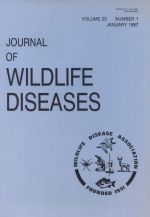Histopathologic, ultrastructural, and negative-staining studies indicated that nodular lesions on the flippers, head, and necks of recently weaned, captive grey seals (Halichoerus grypus) were similar to sealpox lesions reported from several other species of seals. Virions associated with the nodules were characteristic of the parapoxvirus subgroup of pox viruses. Two of the three persons handling the seals developed nodular lesions similar to “milker's nodules, ” the characteristic lesion in persons infected with parapoxvirus. The clinical course of the parapoxvirus infection in both the grey seals and their handlers is described. It was concluded that although sealpox is transmissible to man, the mild clinical manifestations place it in the nuisance category of zoonotic diseases.
How to translate text using browser tools
1 January 1987
SEALPOX IN CAPTIVE GREY SEALS (HALICHOERUS GRYPUS) AND THEIR HANDLERS
Brad D. Hicks,
Graham A. J. Worthy





